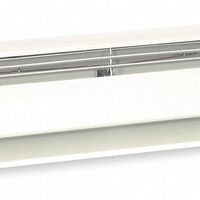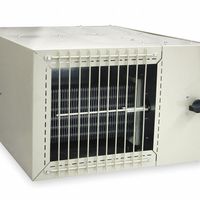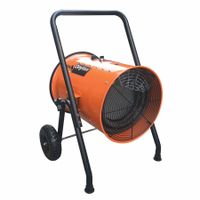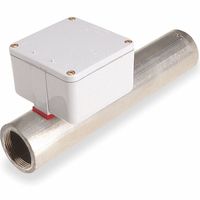Call +(254) 703 030 000 / 751 483 999 / 721 704 777
- Home
- Hvac And Refrigeration
- Heaters
- Electric Heaters
.....Read More
Frequently Asked Questions
What are the benefits of using electric heaters indoors?
Electric heaters offer several benefits for indoor use:
1. **Energy Efficiency**: Electric heaters convert almost all the electricity they consume into heat, making them highly efficient. This can lead to lower energy bills compared to other heating methods.
2. **Safety**: Modern electric heaters come with safety features such as automatic shut-off, tip-over protection, and cool-to-touch surfaces, reducing the risk of fire and burns.
3. **Ease of Installation**: Electric heaters are easy to install and require no special venting or fuel storage, unlike gas or oil heaters. They simply need to be plugged into a standard electrical outlet.
4. **Portability**: Many electric heaters are portable, allowing users to move them from room to room as needed, providing targeted heating where it is most required.
5. **Low Maintenance**: Electric heaters require minimal maintenance compared to other heating systems. There are no filters to change or fuel to refill, and they do not produce soot or ash.
6. **Quiet Operation**: Electric heaters generally operate quietly, making them suitable for use in bedrooms, offices, and other quiet spaces.
7. **Instant Heat**: Electric heaters provide immediate warmth, as they do not need time to heat up like some central heating systems.
8. **Environmentally Friendly**: Electric heaters do not produce emissions, making them a cleaner option for indoor air quality. When powered by renewable energy sources, they can be a sustainable heating choice.
9. **Cost-Effective**: Electric heaters are often less expensive to purchase and install than central heating systems, making them a cost-effective option for supplemental heating.
10. **Versatility**: Available in various styles and sizes, electric heaters can suit different aesthetic preferences and space requirements, from compact personal heaters to larger units for bigger rooms.
How do electric heaters compare to gas heaters in terms of safety?
Electric heaters are generally considered safer than gas heaters for several reasons. Firstly, electric heaters do not involve combustion, eliminating the risk of carbon monoxide poisoning, which is a significant concern with gas heaters. Gas heaters require proper ventilation to prevent the buildup of this odorless, toxic gas, whereas electric heaters do not produce any emissions.
Secondly, electric heaters have fewer components that can malfunction compared to gas heaters. Gas heaters involve burners, pilot lights, and gas lines, all of which can pose safety risks if not properly maintained. Electric heaters, on the other hand, primarily rely on electrical components, which are less prone to dangerous failures if used correctly.
Thirdly, electric heaters typically have built-in safety features such as automatic shut-off mechanisms that activate if the unit overheats or tips over. While some gas heaters also have safety features, the risk of gas leaks or explosions remains a concern, especially if the heater is not regularly inspected and maintained.
However, electric heaters are not without risks. They can cause fires if placed too close to flammable materials or if they overheat due to prolonged use. It is crucial to follow manufacturer guidelines and ensure that electric heaters are used in a safe manner, such as keeping them away from curtains, furniture, and other combustible items.
In summary, while both electric and gas heaters have safety considerations, electric heaters are generally viewed as safer due to the absence of combustion and associated risks. Proper usage and maintenance are essential for both types to ensure safety.
Can electric heaters be used as a primary heat source?
Yes, electric heaters can be used as a primary heat source, but several factors should be considered. Electric heaters are versatile and come in various forms, such as baseboard heaters, wall heaters, and portable space heaters. They are easy to install, require minimal maintenance, and can be used in areas where other heating options might not be feasible.
However, the feasibility of using electric heaters as a primary heat source depends on the size of the space, insulation quality, and local climate. In smaller, well-insulated homes or apartments, electric heaters can efficiently maintain comfortable temperatures. They are particularly effective in regions with milder winters, where heating demands are lower.
Cost is a significant consideration. Electricity is often more expensive than natural gas, propane, or oil, making electric heating potentially costly in areas with high electricity rates. Energy efficiency varies among electric heaters, with some models offering better performance and lower operating costs. Using programmable thermostats and energy-efficient models can help mitigate expenses.
Environmental impact is another factor. While electric heaters produce no direct emissions, the environmental footprint depends on the electricity source. Renewable energy sources like wind or solar reduce the carbon footprint, whereas coal or natural gas-based electricity increases it.
In summary, electric heaters can serve as a primary heat source, especially in smaller, well-insulated spaces or regions with mild climates. However, considerations regarding cost, energy efficiency, and environmental impact are crucial in determining their suitability.
What types of electric heaters are best for small spaces?
For small spaces, the best types of electric heaters are those that efficiently provide warmth while being compact and safe. Here are some options:
1. **Ceramic Heaters**: These heaters use ceramic plates to produce heat, which is then distributed by a fan. They are compact, heat up quickly, and are energy-efficient, making them ideal for small spaces. Many models come with adjustable thermostats and safety features like tip-over protection.
2. **Oil-Filled Radiators**: These heaters are filled with oil that is heated by an electric element. They provide consistent and long-lasting heat even after being turned off. They are silent, making them suitable for bedrooms or offices, and often come with wheels for easy mobility.
3. **Infrared Heaters**: Infrared heaters warm objects and people directly rather than heating the air. They are efficient for small spaces as they provide instant heat and are often designed to be wall-mounted, saving floor space. They are also quiet and can be more energy-efficient than other types.
4. **Panel Heaters**: These slim heaters can be wall-mounted or free-standing. They are designed to provide gentle, consistent heat and are often used as supplementary heating. Their sleek design makes them a good choice for small spaces where aesthetics are a concern.
5. **Fan Heaters**: These heaters use an electric element and a fan to blow warm air into the room. They are lightweight, portable, and provide quick heat, making them suitable for small spaces that need rapid warming.
When choosing an electric heater for a small space, consider factors like energy efficiency, safety features, noise level, and the specific heating needs of the space.
How energy-efficient are electric heaters compared to other heating options?
Electric heaters are generally considered to be 100% energy-efficient in terms of converting electricity into heat, as nearly all the electrical energy is transformed into thermal energy. However, this does not necessarily make them the most cost-effective or environmentally friendly option compared to other heating systems.
Gas furnaces, for example, can have efficiency ratings ranging from 78% to 98%, depending on the model and age. While they may not convert energy as efficiently as electric heaters, natural gas is often cheaper than electricity, making gas furnaces more cost-effective in many regions.
Heat pumps, which can be air-source or ground-source (geothermal), are more energy-efficient than electric heaters. They transfer heat rather than generate it, achieving efficiencies of 200% to 300% or more. This means they can produce two to three times more heat energy than the electrical energy they consume.
Oil furnaces are less efficient, with ratings typically between 70% and 90%. They are often more expensive to operate due to fluctuating oil prices and are less environmentally friendly due to higher carbon emissions.
Wood-burning stoves and pellet stoves can be efficient in terms of fuel use, but they require manual operation and regular maintenance. Their efficiency can vary widely based on the type of wood or pellets used and the stove's design.
In summary, while electric heaters are highly efficient in converting electricity to heat, other systems like heat pumps offer greater overall energy efficiency and cost-effectiveness. The choice of heating system should consider factors such as local energy costs, environmental impact, and specific heating needs.
What maintenance is required for electric heaters?
Electric heaters require regular maintenance to ensure efficient operation and longevity. Here are the key maintenance tasks:
1. **Cleaning**: Dust and debris can accumulate on the heater's surface and internal components, reducing efficiency and potentially causing overheating. Regularly clean the exterior with a soft, damp cloth and use a vacuum with a brush attachment to remove dust from vents and grills.
2. **Inspecting Power Cords and Connections**: Check the power cord for any signs of wear, fraying, or damage. Ensure that all connections are secure and that there are no exposed wires. Replace damaged cords immediately to prevent electrical hazards.
3. **Checking the Thermostat**: Ensure the thermostat is functioning correctly by setting it to different temperatures and observing if the heater responds appropriately. A malfunctioning thermostat can lead to inefficient heating or overheating.
4. **Examining Heating Elements**: Inspect the heating elements for any signs of damage or wear. If the heater is not producing enough heat, the elements may need to be replaced.
5. **Testing Safety Features**: Test the heater's safety features, such as the tip-over switch and overheat protection, to ensure they are working correctly. These features are crucial for preventing accidents and fires.
6. **Lubricating Moving Parts**: If the heater has a fan or other moving parts, lubricate them as per the manufacturer's instructions to ensure smooth operation and reduce noise.
7. **Professional Servicing**: For complex issues or annual maintenance, consider hiring a professional technician to inspect and service the heater. They can perform detailed checks and repairs that may not be possible for the average user.
Regular maintenance not only enhances the performance of electric heaters but also extends their lifespan and ensures safety.
Are electric heaters cost-effective for long-term use?
Electric heaters can be cost-effective for long-term use depending on several factors, including the specific heating needs, electricity rates, and the efficiency of the heater.
1. **Efficiency**: Electric heaters are generally 100% efficient at converting electricity into heat. However, the cost-effectiveness depends on the type of heater. For instance, heat pumps, which are a type of electric heater, can be more efficient than traditional electric resistance heaters because they transfer heat rather than generate it.
2. **Electricity Rates**: The cost of electricity in your area significantly impacts the cost-effectiveness of electric heaters. In regions with high electricity rates, electric heating can be expensive compared to other heating options like natural gas or oil.
3. **Usage**: Electric heaters can be cost-effective for supplemental heating or in areas with mild winters. They are ideal for heating specific rooms rather than an entire house, which can reduce overall energy consumption.
4. **Installation and Maintenance**: Electric heaters typically have lower installation costs compared to systems like gas furnaces. They also require less maintenance, which can contribute to long-term savings.
5. **Environmental Impact**: If the electricity is sourced from renewable energy, electric heaters can be more environmentally friendly, potentially offering long-term savings through incentives or lower carbon taxes.
6. **Building Insulation**: Well-insulated homes retain heat better, making electric heaters more cost-effective as they require less energy to maintain comfortable temperatures.
In summary, electric heaters can be cost-effective for long-term use in well-insulated homes, particularly in areas with low electricity costs or when used for targeted heating. However, for whole-house heating in colder climates, other options might be more economical.






